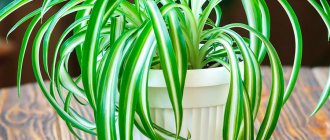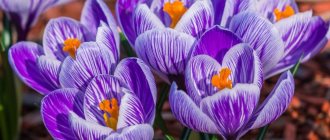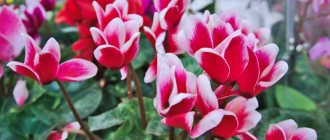What kind is this?
Phalaenopsis is a herbaceous plant belonging to the Orchid family. Under natural conditions it grows in hot climates with high humidity, mountain and lowland forests.
The plant grows straight up, reaching 50 centimeters . There are a great many color variations, from plain to two-color, striped, etc. The flowering period is from 2 to 6 months, sometimes it can bloom 2 times a year. An adult plant has 4-6 leaves; two large fleshy leaves grow in a year.
Phalaenopsis got its name because the flower resembles a fluttering butterfly.
3. Phalaenopsis varieties
It is very difficult to describe all varieties of phalaenopsis - after all, there are a great many of them, let’s look at just a few.
3.1. Schiller's Phalaenopsis - Phalaenopsis schilleriana
A profusely blooming species with large, pink flowers on drooping stalks that have a rose scent. The homeland of the plant is the Philippines. It has become widespread due to its unpretentiousness and tolerance to low lighting levels. An excellent hanging plant, which during the flowering period will hang large branched flower stalks with a cascade of pink flowers over the edges of a hanging flowerpot.
↑ Up,
3.2.Phalaenopsis Sogo - Phalaenopsis Sogo
A small, compact, large-flowered orchid with very bright colors of buds in all colors of the rainbow. Among this variety there are variegated plants with yellow longitudinal stripes on thick, fleshy leaves. The orchid's peduncles are strong, erect, and during the flowering period the plant emits a very pleasant aroma.
↑ Up,
3.3. Phalaenopsis Liodoro - Phalaenopsis Liodoro
A miniature multi-flowered subspecies with bright, soft, green leaves and short, often drooping flower stalks. The flowers are very brightly colored - the edges of the petals have a yellow tint, and towards the center they are abundantly covered with small specks, merging into a solid pink or lilac tone.
↑ Up,
3.4.Phalaenopsis Mini Mark
A very beautiful, small-flowered plant, reaching a height of only 10 - 15 cm. The leaves are dark green, relatively large, glossy, slightly bent along the central vein. The peduncles are tall and thin, bearing small flowers at the top with white oblong petals covered with red or pink specks - freckles. The lower lip is painted a bright orange shade.
↑ Up,
Photo
Next you can see what phalaenopsis looks like in the photo.
Recommendations for care
Creating the right environment is very important:
- The most important factor for phalaenopsis is light. In natural conditions, the plant lives under the canopy of trees, so although they need a lot of light, it should not be direct sunlight.
- The second most important factor is watering; you can’t overdry them, but this doesn’t mean you need to water them. The humidity in the room is not important for phalaenopsis, the main thing is proper watering.
Unlike other types of orchids, phalaenopsis does not require annual replanting, special fertilizers, or daily spraying. But a newly purchased plant needs special care. In a new place, the plant begins a period of adaptation . Its leaves and buds may begin to fade.
Even after a thorough inspection in the store, phalaenopsis can carry parasites, so it needs to be isolated from other plants for a couple of weeks. If everything is fine with it after quarantine, you can place it next to other flowers.
If you find salted bark in a pot, remove it immediately. Make sure that there are drainage holes in the pot; if there are none, make them, but do not damage the roots.
The plant should only be replanted if the plant looks sick . damage is visible on the roots or it falls out of the pot.
It is necessary to accustom phalaenopsis to light gradually; do not immediately place it in a brightly lit place.
How to propagate at home?
Orchid propagation is not a complicated procedure. At home, this is usually done using vegetative parts of the plant:
- By cuttings from a peduncle . After flowering, several dormant buds remain on the living peduncle. The stem is cut and divided into parts so that in the middle of each part there is a dormant bud. The fragments are placed in a container with moistened sphagnum and covered with polyethylene on top. After a few days, babies form from the buds, which are carefully separated and planted.
- Children . This is the easiest way. The orchid produces babies on the peduncle and from dormant buds on the trunk of the plant. You just need to wait until the baby’s roots grow to plant it in a separate pot.
- Dividing the root . The plant is carefully removed from the pot and freed from the substrate. The rhizome is cut into pieces, leaving 2-3 buds per sprout. After treating the cuts with charcoal, each separated part is placed in a pot with fresh substrate.
New plants are planted according to their requirements for the substrate and the container in which they will actively develop.
Step-by-step instructions: how to properly care for a flower at home
Let's look at it in detail so that novice gardeners can understand everything about how to care for a homemade Phalinopsis orchid growing on a windowsill in a pot.
Wise choice of location
The window sill is the best place, but remember that direct sunlight is harmful to leaves . Choose windows facing Northeast, West, East, do not forget about shading. You can place it away from a window with artificial light.
For phalaenopsis, light plays a decisive role. It blooms only when the daylight hours are at least 12 hours.
Choosing a pot for him
There are many myths about orchid pots. The most popular one says that the pot must be transparent, but this is not so.
The main thing for phalaenopsis is that there are drainage holes at the bottom for air access to the root system. Phalaenopsis is sold in transparent pots for easy inspection of the roots. Even some growers grow them in opaque pots.
The pot should not be small; it is desirable that it be the same in height and width. In tall pots, sugar will accumulate on top and the bottom will be wet . Taking into account all these conclusions, the conclusion follows: phalaenopsis does not care what kind of pot it is, transparent or ceramic. The main thing is that it fits into the cube and there are drainage holes at the bottom, at least one.
Priming
Regular soil is not suitable for phalaenopsis. For the roots to work properly, they need air, so it is planted in a special substrate.
The correct substrate meets two criteria:
- Moisture holding capacity - takes and retains moisture around the roots, rather than drying out in a day.
- Air permeability - it should not be compacted. Well-cooked pine bark, for at least 15 hours, 2-3 centimeters in size, is the best option. You can also buy ready-made substrate in special stores.
Lighting
Lighting should be diffused to avoid burns. The length of daylight depends on the time of year; in winter it should be 12-14 hours; in summer, on the contrary, avoid excess light.
In autumn, during the flowering period, it is better to add additional light to the flower, otherwise the buds will dry out due to lack of light.
We invite you to watch a video about the effect of lighting on orchids:
Humidity
Air humidity is completely unimportant for phalaenopsis. In their natural environment, they receive the necessary moisture every day with the help of rain, dew, etc., but gardeners have found a way out of this situation - the correct substrate is moisture-absorbing and breathable. The substrate will retain the necessary moisture around the roots. The main thing is proper watering. There is no need to spray plants daily or increase humidity with basins and wet towels.
Temperature
Phalaenopsis grow in the tropics, so they tolerate our heat well, and in the cold season it is important for them that the temperature does not drop below 15 degrees. They need a period of cold keeping, but in the spring the heating in the apartments is turned off, and in the fall it does not turn on yet and the temperature itself drops.
Watering
The frequency of watering depends on the time of year and air temperature. Phalaenopsis needs a constantly slightly moist substrate. The substrate should be slightly damp, not wet or dry.
Phalaenopsis does not tolerate drought . Overdrying leads to death.
Water for irrigation should be soft, the softer the better. It is enough to let the water sit for two to three days.
It is necessary to water first by pouring, then by soaking. The entire surface of the substrate is spilled with 2 - 3 liters of water, then the flower is soaked. You decide for yourself how long to soak, it all depends on the substrate, it should hold moisture for at least a week.
If the substrate does not hold moisture, soak longer, for example 1-2 hours.
We invite you to watch a video on how to properly water a phalaenopsis orchid:
Fertilizers
You can feed phalaenopsis only during the growth period . In winter, during the dormant period, as well as only transplanted and diseased plants, it is impossible to fertilize. It is worth fertilizing between April and September inclusive, when the plant is actively growing. Special fertilizers are sold in flower shops; they must be fertilized strictly following the instructions, diluting with irrigation water. Feeding should be done alternating regular watering and watering with fertilizer to avoid salting.
Inspecting the plant for problems
With proper care, it will not hurt. Periodically inspect the flower and substrate. The substrate should be free of white deposits (salting), mold and bugs. Keep an eye on the roots and leaves. The roots are not dried out or rotten, the leaves are juicy, strong and green.
Secrets of flowering
As a rule, there are no special problems with the flowering of healthy plants , but sometimes it happens that large and well-growing specimens do not form flower stalks for several years. The reason for this behavior of the plant may be:
- too regular and careful care;
- the substrate is not allowed to dry out between waterings;
- excessive amounts of fertilizer;
- constant temperature day and night.
Despite the relative stability of natural conditions, even in the tropics there is a slight difference in day and night temperatures, and the rainy season is replaced by a relatively dry period. It is during the dry period that plants bloom.
Therefore, in order to stimulate flowering, sometimes it is enough to simply forget about the flower for a while, creating extreme conditions for it that will stimulate flowering.
Interesting! Sometimes you can stimulate the formation of flower stalks with the help of darkness. To do this, the plants are placed in a dark place for 3-7 days or a bag of thick dark material is put on it.
Errors and their correction
The main mistakes are incorrect watering and lighting:
If you water incorrectly , you can ruin the root system; it will either begin to rot or dry out. What to do in this case? Here is a list of actions to take if problems with roots are detected:- It is necessary to carefully examine the root system without damaging the roots even further.
Rinse the remaining roots thoroughly.
- Dry them in a well-ventilated place.
- Treat the sections with activated carbon.
- Transplant into a new substrate.
- In case of leaf burns , you need to place the flower in a shaded place, and also monitor optimal watering. The damaged leaf must be cut to the healthy part, subsequently removed only when it turns completely yellow.
- If bacterial diseases or bugs are discovered , all affected leaves must be removed and the cut areas treated with charcoal or iodine. Place the phalaenopsis in quarantine so that other plants do not become infected; if necessary, use various preparations; you can buy them at a flower shop. If after 2 weeks of quarantine the flower is in order, you can return it to the flower garden.
Remember, you can only feed a healthy plant during the period of active growth. You cannot immediately place it in direct sunlight; the place must be shaded.
When the plant recovers and new roots begin to form, you can begin feeding and use root growth stimulants, strictly according to the instructions for the drug. It is also necessary to install a proper watering system.
Temperature
For an orchid, temperature is one of the determining factors of growth. Photosynthesis allows the plant to receive food and spend energy on life. It is this process that plays a major role in the process of building new cells and tissues. All biochemical processes occur only at a temperature of 18 - 30 degrees.
Phalaenopsis hybrids are distinguished by good immunity to diseases. They perfectly adapt even to the difficult conditions of harsh Russian winters, which are characterized by an air temperature of +15 ° C in a heated room. But for active growth and flowering, an average daily temperature of 20 to 25 ° C is required. For an orchid to bloom, a slight temperature difference is necessary. Optimal if it is 3-5 oC. A larger jump can lead to hypothermia and the development of fungal infections.
During the summer season, when temperatures rise, it is necessary to ensure adequate ventilation. There is a little secret - if the plant has entered the flowering phase, you can move it to a cool room. In such conditions, flowering slows down, and the beauty of the orchid will delight you much longer.
Pests
Tick . It affects the leaves and buds of the plant, you may see thin webbing and small white dots. Acaricides are used for destruction.- Aphid . You can see it on the underside of the leaf - it is a white coating.
- Scale insects and scale insects . If your plant (stems, leaves) begins to become covered with small light yellow spots turning brown, and sticky black spots appear on the leaves, you need to immediately begin treating the plant with phytoverm.
- Thrips . When infected, black dots of excrement can be seen on the leaves, the color changes to silver, and later the infected areas will darken. For treatment, insecticides must be used.
Phalaenopsis is ready to please you constantly, requiring only minimal care in return.
Maintain temperature conditions and water properly, protect the plant from direct sunlight. Do not make mistakes in caring for phalaenopsis and then phalaenopsis butterflies will regularly flutter in your flower garden. To make your flower garden even more beautiful, place several pots of these wonderful flowers in it, and you simply won’t need others.
We invite you to watch a video about diseases and pests of orchids:
Once every 2-3 years, the orchid needs to be replanted. Read about when is the best time to replant a plant and how to plant a root child.











